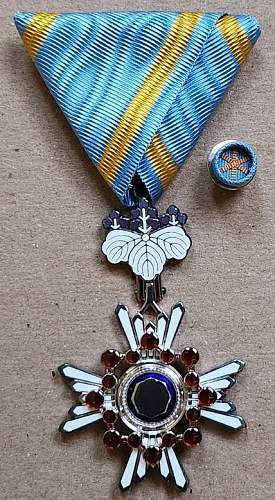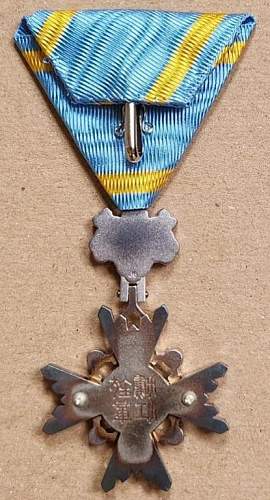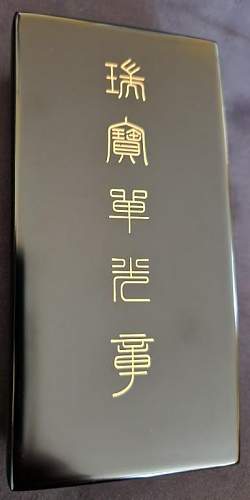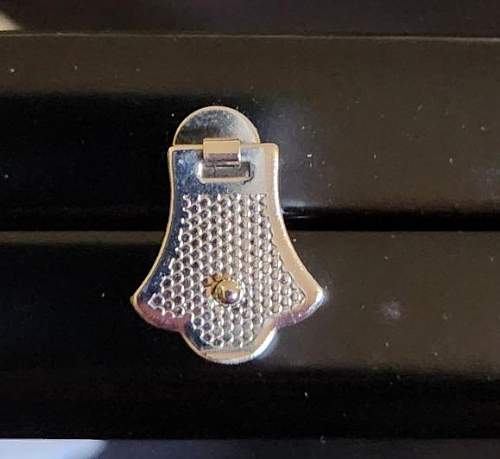Post-2003 Reform Orders of the Sacred Treasure
Article about: I would like to provide, to the best of my ability, detailed descriptions; measurements; etc. of Post-2003 Reform Orders of the Sacred Treasure. In this sense I hope to build on Nyle Monday
-
 Post-2003 Reform Orders of the Sacred Treasure
Post-2003 Reform Orders of the Sacred Treasure
I would like to provide, to the best of my ability, detailed descriptions; measurements; etc. of Post-2003 Reform Orders of the Sacred Treasure. In this sense I hope to build on Nyle Monday’s “Recent Reforms in the Japanese Honor System” from 2005 (Journal of the Orders and Medals Society of America Vol. 56, No. 6), an article written 19 years ago and before he had the chance to examine in hand any of the Post-2003 Reform orders. His article can be found here: https://www.omsa.org/files/jomsa_arc...Vol56_6_25.pdf.
I won't bother with a detailed description of the “core” part of the Post-2003 Reform OSTs that were carried over from the pre-2003 orders, as such a description is easily available in either Peterson’s Orders and Medals of Japan and Associated States, Third Edition or Wikipedia. I will, however, have a thing or two to say about the lacquered cases.
A note about the Wikipedia article: the article states that the OST represents all three of the Imperial treasures: Yata mirror, Yasakani jewel, and the grass cutting sword. The article claims that the enameled white rays represent the sword. This assertion is repeated on some other websites discussing the OST. Perhaps the author of this section of the Wikipedia article assumes (1) that the OST must by necessity represent all three of the Imperial Regalia instead of just two and (2) that the white enameled rays obviously represent the sword because the rays end in a point, like a sword would. This is the first time that I have seen such an assertion. On page 34 of the third edition of his book Peterson quotes from the Imperial Edict establishing the OST (No. 1 January 4, 1888) and his second quoted sentence is quite clear: “‘[t]he badge is decorated with the Mirror and Gems.’” If the Imperial Edict had mentioned that the grass cutting sword was also represented in the badge’s design, then I assume that Peterson would have quoted that. The author of the Wikipedia article cites no source for the claim that the OST represents all three Imperial treasures.
A note about my measurements and photos: I used a digital caliper that is accurate to within .01mm and I rounded up or down as appropriate. The measurements are of the particular pieces that I own but I assume that they are very close to what the standard measurements should be. My pictures are from a cell phone and not taken in the best lighting, so the pictures might fail to accurately represent the true colors with the highest degree of accuracy. My pictures of case lids are at an angle in order to minimize, to the greatest extent possible, the reflection in the lacquer.
For now I only possess the lowest four Post-2003 Reform OSTs, corresponding to the pre-reform 6th, 5th, 4th, and 3rd classes (the pre-reform 8th and 7th classes having been abolished as part of the reform). I do not foresee myself being able to obtain the top two, but one never knows. I hope that you find this four part “series”, to be created over the next couple of weeks, interesting. I would be delighted if any of you add to it, improve it, criticize it, and comment on it as you see fit. I did a search on this forum to see if something like this already exists, but nothing turned up. At least not using the terms by which I searched.
Thank you,
Tracy
The Order of the Sacred Treasure, Silver Rays. Formally the 6th class in the pre-reform orders.
The triangular ribbon shape has been retained and it is approximately 47mm (at its widest part) by 40mm long. The color is a shade of blue, and after looking through 144 different shades of blue to me the ribbon color looks closest to cornflower blue but per Akira Komiya’s information in post #10 below “...the ribbon was specified as having a woven base in indigo.”. On the ribbon is a 4mm orangish yellow stripe (also see Akira Komiya’s post #10 below) that is 3mm from each edge.
The central design is per the pre-reform medal: white enameled rays, paste jewels and their connecting lines in red (on page 34 of the third edition of his book Peterson uses the term “red paste”, implying that the jewels and their connecting lines are a type of cut glass), polished silver mirror on a dark blue enameled background, all non-enameled medal surfaces in silver. Like the pre-reform medal, the width of the new medal is approximately 40mm from ray tip to ray tip. However, given the new suspension the length is now approximately 57mm from the top of the 12h paulownia flower to the tip of either of the longest bottom two rays. The suspension is new and appears to be the same suspension device used on the post-reform Order of the Rising Sun, with the exception of the enameling on the obverse leaves and flower stems. On the OST Silver Rays the three paulownia leaves and flower stems are enameled white and the leaves have silver veins. The flowers are in a 3; 5; 3 configuration, are enameled light purple, and the silver medal fills in between them and the stems. The piece on the suspension through which the metal ring attaching the ribbon is threaded is no longer in the shape of a ball, it is now in the shape of a puck.
The entire reverse is silver with a sandblasted looking finish, in contrast to the smooth finish of the pre-reform OSTs. At approximately the midway point of the 3h and 9h arms is a phillips head screw, obviously fasteners for the two piece construction. Like the pre-reform pieces, the four “order of merit” characters are arranged in a square in the center of the badge. The reverse of the leaves and flowers suspension device is flat and featureless; there is no detailed representation of the flowers and stems, and this is just like the reverse of the suspension device of the post-reform Orders of the Rising Sun. My example has the hallmark J6 stamped on the bottom leaf at 6h. As of May 21, 2024 this hallmark is not listed on the Medals of Asia website at Two-letter and letter-digit Marks on Japanese Orders and Medals | Medals of Asia.
The case in my example is black lacquered wood. I know this for a fact because there is damage to the right, inside edge of the top of the case and the wood is clearly showing through. The case is approximately 65mm wide by 130mm long by 30mm high. The top and bottom are joined by a silver colored hinge at the back, fully visible when the lid is open and with three phillips head screws on the top and the bottom hinge plates. The lid is secured by a pin-and-hole silver clasp with a circle-next-to-circle design bordered by a smooth edge. The inside top is of a purple colored satin like material, and the medalbed, recessed in the outline of the medal, is a purple colored velvet like material.
The round rosette is of the same colors as the ribbon, blue with six gold stripes radiating from the center. There is no hallmark on the metal portion of it.
Obverse with rosette:

Reverse (barely visible in this photo is the J6 hallmark stamped on the bottom leaf at 6h):

Lacquered case lid with the script 瑞寶単光章, Order of the Sacred Treasure Silver Rays:

Close up of the clasp:

Last edited by TracA; 05-27-2024 at 12:30 AM.
Reason: Updated official ribbon color per Akira Komiya's information.
-

I'll tell Nyle you quoted him. He's my best friend of over 20 years and we meet every Sunday to talk about such stuff. He studied under Donn Draeger in Japan and Hawaii; loves Orders and Medals; archaeologist, historian, deep-sea qualified hard-hat diver ..... and now is the senior research librarian and tenured faculty at San Jose State University!!
Cheers,
-- Guy
-

Hello Guy,
It is a bit of a small world, isn't it? Please do tell him. I was a member of OMSA when his article came out, and I read it eagerly when I had received that issue in the mail.
Fun fact, of sorts: when I learned about the reform changes to the award system I contacted someone at OMSA (can't recall who) and proposed writing such an article. He encouraged me to do so, and I had a long draft prepared but it was not submitted before Nyle Monday's article came out. After reading his I was glad that I never submitted mine for publication, as the article he had written was leaps and bounds better than mine.
All the best,
Tracy
-


by
TracA

Hello Guy,
It is a bit of a small world, isn't it? Please do tell him. I was a member of OMSA when his article came out, and I read it eagerly when I had received that issue in the mail...
...I had a long draft prepared but it was not submitted before Nyle Monday's article came out. After reading his I was glad that I never submitted mine for publication, as the article he had written was leaps and bounds better than mine.
Hi Tracy,
When I first mentioned this to Nyle he was shocked that anybody recalled his article; in a subsequent email he wrote:

by
Nyle Monday
Wow, kind words indeed! Thank him for me.
Cheers,
-- Guy
-

Thank you, Guy. I'm glad to give praise where and when it is due.
Tracy
-
-
-

Thank you, Akira. Your compliment is greatly appreciated. Also greatly appreciated is your translation of the cabinet order of November 22, 1888 and upload of the attending illustrations. I will keep them and your translation for my records.
All the best,
Tracy
-

The Order of the Sacred Treasure, Gold and Silver Rays. Formally the 5th class in the pre-reform orders.
The triangular ribbon shape has been retained and on my example it is approximately 46mm (at its widest part) by 39mm long. Although to me the color looks like cornflower blue, per Akira Komiya’s information in post #10 below “...the ribbon was specified as having a woven base in indigo”. There is a 4mm orangish yellow stripe (also see Akira Komiya’s post #10 below) that is 3mm from each edge on the ribbon.
The central design is per the pre-reform medal: the rays are enameled white, the paste jewels and their connecting lines are red (not enameled, red glass?), and the mirror is polished silver on a dark blue (indigo) enameled background. The front and side surfaces of the beaded inner and double raised outer rings, attachment to the paulownia leaf suspension, as well as the 12 short rays are all in gilt. The front outline and side surfaces of both the eight longest rays as well as the red jewels and their red connecting lines are in silver. Like the pre-reform medal, the width of the new medal is approximately 45mm from ray tip to ray tip. However, because the post-reform medal has a new suspension the length is approximately 64mm from the top of the 12h paulownia flower to the tip of either of the longest bottom two rays. The new suspension appears to be the same one used on the post-reform Order of the Rising Sun, the only difference being the color of the enamel on the obverse leaves and flower stems. On the OST Gold and Silver Rays the three paulownia leaves and flower stems are enameled white and the leaves have silver veins. The flowers are in a 3, 5, 3 configuration and are enameled light purple. Like the OST Silver Rays on which the silver colored medal fills in between them and the stems, on my Gold and Silver rays example this fill-in is tarnished a beautiful blue that almost makes it appear as if this area is enameled blue. The piece on the suspension through which is threaded the metal ring attaching the ribbon is now shaped like a puck.
The entire reverse is silver with a sandblasted looking finish. At approximately the midway point of the 3h and 9h arms is a phillips head screw, obviously fasteners for the two piece construction. Like the pre-reform pieces, the four “order of merit” characters are arranged in a square in the center of the badge and their recesses are gilt. The reverse of the leaves and flowers suspension device is flat and featureless; there is no detailed representation of the flowers and stems. This is just like the reverse of the suspension device of the post-reform Orders of the Rising Sun. My example has the hallmark F5 stamped on the bottom leaf at 6h. As of May 23, 2024 this hallmark is not listed on the Medals of Asia website at Two-letter and letter-digit Marks on Japanese Orders and Medals | Medals of Asia.
The case in my example is lacquered black and I assume that it is made of wood. Unlike my OST Silver Rays, there is no damage through which the case material shows itself. However, given that the case for the Silver Rays is made of wood I would find it odd if the case for a higher award were not made of wood. The dimensions of the case are as follows: approximately 65mm wide by 130mm long by 30mm high. The top and bottom are joined by a silver colored hinge at the back, fully visible when the lid is open, and the hinge is secured to the top and bottom of the case by three phillips head screws each. The lid is secured shut by a pin-and-hole silver clasp with a circle-next-to-circle design bordered by a smooth edge (see above OST Silver Rays for a picture). The inside top is of a purple colored satin like material, and the medalbed, recessed in the outline of the medal, is a purple colored velvet like material.
The round rosette is of the same colors as the ribbon, blue with eight gold stripes radiating from the center. There is no hallmark on the metal portion of it.
All the best,
Tracy
Obverse with rosette:

Reverse (the F5 hallmark is stamped on the bottom leaf at 6h):

Lacquered case lid with the script 瑞寶双光章, Order of the Sacred Treasure Gold and Silver Rays:

Last edited by TracA; 05-27-2024 at 12:34 AM.
Reason: Update official ribbon color per Akira Komiya's information.
-

The ribbon for the Order of the Sacred Treasure prior to 2003 was specified as having a woven base in light indigo with 2 stripes in orangish yellow (織地淡藍色双線橙黄)although the actual colors varied greatly with the "light indigo" mostly being an almost off white color and the "orangish yellow" sometimes even being in a pink color. (I understand the ribbon color scheme is one indicator of the vintage of the award, alhough I myself am not too familiar with such.)
In the 2003 order, the ribbon was specified as having a woven base in indigo with 2 stripes in orangish yellow (織地藍色、双線橙黄色) indicating that the color was changed to a darker color as you see today.
 Posting Permissions
Posting Permissions
- You may not post new threads
- You may not post replies
- You may not post attachments
- You may not edit your posts
-
Forum Rules








 .
.





Bookmarks